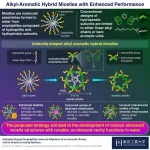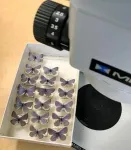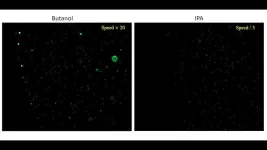(Press-News.org)
Micelles assemble in water from amphiphilic molecules, composed of hydrophilic and hydrophobic frameworks. They can be found all around us, for example in soaps, detergents, and shampoos. Their main application is the water-solubilization of insoluble molecules through encapsulation into hydrophobic cavities. These cavities are conventionally composed of linear alkyl-chains, providing good interactions with alkyl-based guests, yet poor interactions with aromatic compounds. In addition, the rather weak intermolecular alkyl-alkyl type interactions result in an overall poor stability against heat and dilution.
In 2013, Kei Kondo and Michito Yoshizawa from Tokyo Tech’s Laboratory for Chemistry and Life Science in Japan reported a new class of micelles, so called aromatic micelles, formed from bent anthracene-based amphiphiles AA. Aromatic micelles show high stability in water and excellent host functions towards aromatic guests, however only moderately interact with alkylated frameworks. To develop new micelles with unprecedented properties, the group around Masaya Endo, Dr. Lorenzo Catti, and Prof. Yoshizawa now achieved the preparation of alkyl-aromatic hybrid micelles obtained from umbrella-shaped amphiphiles UA, published in Angewandte Chemie on April 15. The new amphiphiles feature a linear alkyl-chain flanked by two aromatic panels (i.e., anthracene units), and quantitatively self-assemble in water into small spherical micelles of ~2-3 nm in diameter, providing an alkyl core surrounded by an aromatic shell. The micellar alkyl cores were found to be highly compacted and shielded from water as indicated by solvent-repsonsive fluorescent guest probes.
Interestingly, the hexadecyl-based hybrid micelle (UA16)n showed excellent stability against dilution, with an approximately 100-fold and 2000-fold increase in stability as compared to aromatic and alkyl micelles, respectively. The high stability is believed to arise from combined alkyl-alkyl, aromatic-aromatic, and alkyl-aromatic interactions. Micelle (UA16)n furthermore resisted disassembly up to 120 °C, making it suitable for applications under extreme conditions.
“Besides very high stability, the new hybrid micelles provide superior uptake functions toward large alkylated metallodyes. Control experiments with alkyl and aromatic micelles revealed an approximately 600-fold and 6-fold enhancement in uptake efficiency, respectively. Simple mixing of alkyl and aromatic micelles was found to provide no significant enhancement, emphasizing the importance of the new hybrid design”, says Dr. Catti.
Finally, the group revealed the efficient uptake/water-solubilization of large aromatic macrocycles, i.e., cycloparaphenylenes (CPPs), provided by Dr. Tsuchido from Tokyo University of Science. These macrocycles are composed of covalently linked benzene rings and feature intruiging physicochemical properties. For example, subjecting UA16 and 9CPP, constructed from nine linked benzene rings, to a grinding protocol yielded a clear solution containing micellar composites encapsulating in average a single molecule of 9CPP. A combination of experimental and computational data revealed that the alkyl chains of UA16 interpenetrate the 9CPP ring structures, providing so-called pseudorotaxane structures, rarely reported for unfunctionalized cycloparaphenylenes. Additionally, the 9CPP based composites showed strong green emission in water, with a quantum yield of 35%. Larger CPPs were likewise encapsulated with high efficiency.
The team concludes: “While the focus of this study was placed on the combination of alkyl and aromatic hydrophobic frameworks, we are convinced that the generality of the method will allow us to develop a wide range of powerful new amphiphiles by exploring different combinations, for example ones including peptide or fluoroalkane frameworks. The corresponding hybrid micelles are expected to find use as on-demand host structures for solubilization, stabilization, and targeted delivery applications.”
###
About Tokyo Institute of Technology
Tokyo Tech stands at the forefront of research and higher education as the leading university for science and technology in Japan. Tokyo Tech researchers excel in fields ranging from materials science to biology, computer science, and physics. Founded in 1881, Tokyo Tech hosts over 10,000 undergraduate and graduate students per year, who develop into scientific leaders and some of the most sought-after engineers in industry. Embodying the Japanese philosophy of “monotsukuri,” meaning “technical ingenuity and innovation,” the Tokyo Tech community strives to contribute to society through high-impact research.
https://www.titech.ac.jp/english/
END
BALTIMORE, Md. (May 20, 2024) – Scientists seeking to counter the neglect of African Americans in neuroscience research have found evidence that genetic ancestry is responsible for the increased prevalence of certain neurological disorders, such as Alzheimer’s disease and stroke, and decreased prevalence of others, including Parkinson’s disease, in Black Americans, according to new research published May 20 as the June cover story in the journal Nature Neuroscience.
In contrast, the scientists from the Lieber Institute for Brain Development did not find evidence that genetic ancestry is responsible for differences in the ...
Researchers at the University of California San Diego have been awarded a $5.6 million grant through the Coast-to-Coast Consortium (C2C) to further their pioneering efforts with the National Institutes of Health's (NIH) All of Us Research Program.
The award is designated to facilitate participant engagement, enrollment, data collection, and retention. C2C will build on the foundation set by the UCSD-led California Precision Medicine Consortium (CAPMC), established in 2018, which enrolled more than 65,500 participants to the program.
This award follows the program's ...
BEER-SHEVA, Israel, May 20, 2024 – When you disable the brakes on a race car, it quickly crashes. Dr. Barak Rotblat wants to do something similar to brain cancer cells. He wants to disable their ability to survive glucose starvation. In fact, he wants to speed the tumor cells up, so they just as quickly die out. It is a novel approach to brain cancer based on a decade of research in his lab.
He and his students' and co-lead researcher Gabriel Leprivier of the Institute of Neuropathology at University Hospital Düsseldorf ...
A sweeping new Health Blueprint for Southwest Virginia highlights the grave health challenges that grip the rural region but also proposes solutions to help residents live longer, healthier lives.
The Blueprint was assembled by the University of Virginia College at Wise’s Healthy Appalachia Institute, the Southwest Virginia Health Authority, UVA Health’s Center for Telehealth and a coalition of residents and regional healthcare providers. The document identifies priority health concerns for the three health districts in the southwestern corner of Virginia: Lenowisco, Cumberland Plateau and Mount Rogers. These are areas ...
About The Study: Many studies suggest a survival benefit for cancer trial participants. However, these benefits were not detected in studies using designs addressing important sources of bias and confounding. Pooled results of high-quality studies are not consistent with a beneficial effect of trial participation on its own.
Quote from corresponding author Jonathan Kimmelman, Ph.D.:
“Many physicians, policymakers, patient advocates, and research sponsors believe patients have better outcomes when they participate in trials, even if they are in the comparator arm. Educational ...
Fukuoka, Japan—From the rain drops rolling down your window, to the fluid running across a COVID rapid test, we cannot go a day without observing the world of fluid dynamics. Naturally, how liquids traverse across, and through, surfaces are a heavily researched subject, where new discoveries can have profound effects in the fields of energy conversion technology, electronics cooling, biosensors, and micro-/nano-fabrications.
Now, using mathematical modeling and experimentation, researchers from Kyushu University’s Faculty of Engineering have expanded on a fundamental principle in fluid dynamics. Their new findings may ...
ATLANTA - Chemical Insights Research Institute (CIRI) of UL Research Institutes applies cutting edge technologies to evaluate the toxicity of burn-impacted land areas affected by the August 2023 Lahaina wildfires. Created with CIRI research partners from Duke University and the East-West Center (EWC) in Hawai’i, the study known as Lahaina Environmental Assessment Project (LEAP), will collect and analyze residual dust, soil and ash samples from properties affected by the fires. These residues, including fine dust, ...
PLYMOUTH MEETING, PA [May 20, 2024] — The National Comprehensive Cancer Network® (NCCN®) today announced publication of new NCCN Guidelines for Patients®: Small Bowel Adenocarcinoma. This free resource for people facing cancer and caregivers is focused on a rare cancer type that typically occurs in the small intestine, where routine screening is impossible, even for high-risk individuals. The small amount of patient information that exists for this cancer type tends to combine it with other cancers of the small intestine (such as sarcomas, neuroendocrine tumors, or lymphomas) despite very different treatment approaches and results.
The NCCN Guidelines for Patients: ...
Groundbreaking research has provided new insight into the tectonic plate shifts that create some of the Earth’s largest earthquakes and tsunamis.
“This is the first study to employ coastal geology to reconstruct the rupture history of the splay fault system,” said Jessica DePaolis, postdoctoral fellow in Virginia Tech's Department of Geosciences. “These splay faults are closer to the coast, so these tsunamis will be faster to hit the coastline than a tsunami generated only from ...
In 2023, Antarctic sea ice reached historically low levels, with over 2 million square kilometres less ice than usual during winter – equivalent to about ten times the size of the UK. This drastic reduction followed decades of steady growth in sea ice up to 2015, making the sudden decline even more surprising.
Using a large climate dataset called CMIP6, BAS researchers investigated this unprecedented sea ice loss. They analysed data from 18 different climate models to understand the probability of such a significant reduction in sea ice and its connection to climate change.
Lead author Rachel Diamond explained that while 2023's extreme ...







